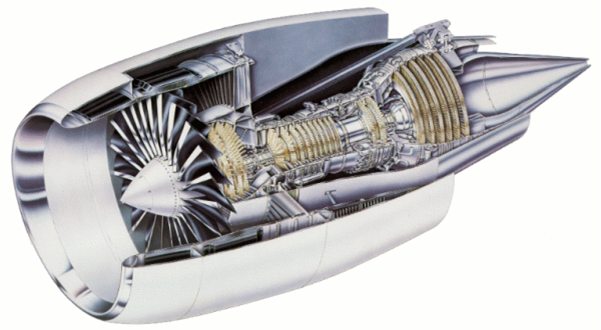- The review power presentation of the last lecture
here
- The midterm exam is scheduled for October 18, 9.00-10.45am
in GMSC 306.
- Find the solution to homework 5, problem 2 here
- Homework 5: choose one problem from homework 4 in addition to
the problems in homework 5. You can do the other problem for extra
credit.
- The course information will also be accesible through the
Blackboard .
This undergraduate level course on Aircraft Propulsion Systems teaches the principles of jet propulsion. The primary focus of the course is on the teaching of thermodynamics and fluid dynamics in aircraft engines. The course provides information that will enable the engineering analysis of ramjets and turbine engines and its separate components including inlets, nozzles, combustion chambers, compressors, and turbines.
Syllabus (.doc)
- Course Objectives
Students successfully completing AE430: "Aircraft Propulsion Systems" should have:
- A basic understanding of thermodynamic cycles of jet engines.
- A basic understanding of the compressible fluid flow in inlets and compressors and turbines.
- A basic understanding of the combustion physics in combustion chambers.
- A basic understanding of the rational behind several types of jet engines.
- The ability to analyze jet engines; determine propulsion efficiency and design inlets and nozzles.
- Course Description
The course relies on the textbook "Mechanics and Thermodynamics of Propulsion" by Philip Hill and Carl Peterson. The course will treat selected chapters from Part I and II of the book. We will first review basic jet propulsion principles (Chapter 1). We will then briefly review thermodynamics, chemistry and compressible fluid mechanics (Chapter 2), followed by a discussion of one-dimensional flow of a perfect gas (Chapter 3). The thermodynamic cycles of ramjets and turbine engines will be the next topic (Chapter 5). We then discuss the fluid dynamics of several aircraft components including inlets and nozzles (Chapter 6), combustion chambers (Chapter 6) and compressors and turbines (Chapter 7 and 8).
- Textbook
Hill. P., Petersen, C., "Mechanics and Thermodynamics of Propulsion", 2nd edition, Addison-Wesley Publishing Company, 1992.
- Supplementary Textbooks
Aircraft Propulsion:
- Flack, R.D.., "Fundamentals of Jet Propulsion", Cambridge University Press, 2005.
- Baskharone, E.A., "Principles of Turbomachinery in Air-Breathing Engines", Cambridge University Press, 2006.
- Kerrebrock J.L., "Aircraft Engines and Gas Turbines", MIT Press, 1992.
- Mattingly, J.D., "Elements of Gas Turbine Propulsion", McGraw-Hill Inc., 1996.
Compressible Flow:
- Anderson, J.D., "Modern Compressible Flow: With Historical Perspective", McGrawHill, 2002.
- Zuker, R.D., and Biblarz, O.,"Fundamentals of Gas Dynamics", John Wiley & Sons Inc., 2002.
- Thompson, P. A. Compressible Fluid Dynamics. Maple Press Company, 1984.
- Saad, M.A.,"Compressible Fluid Flow", Prentice-Hall, 1993.
- Liepmann, H., and A. Roshko. Elements of Gas Dynamics. John Wiley Publishers, 1957.
Computational Fluid Dynamics:
- Anderson, J.D., "Computational Fluid Dynamics: The Basics with Applications", McGrawHill, 1995.
- Katz, J. and A. Plotkin. Low-Speed Aerodynamics: From Wing Theory to Panel Methods. New York, NY: McGraw-Hill, Inc., 1991.
General Fluid Mechanics:
- White, F.M., "Viscous Fluid Flow", McGrawHill, 1991.
- Schlichting, H., Gersten, K., "Boundary-Layer Theory", 8th edition, 2004.
- Prerequisites
Students are expected to have a basic understanding of calculus, elementary physics, thermodynamics (ME352), and high-speed aerodynamics (AE302).
- Homework Problems
A total of approximately six or seven problem sets will be given on Thursdays. The due date for submission of assignments is at the beginning of class the Thursday after the assignment is given. Late submission of assignments is not accepted.
- Exams
There will be one midterm and one final written examination.
- Course Grade
The grading will be based on a weighting of 30 % on the homework, 30 % on the midterm exam, and 40 % on the final exam.
Performance is assessed based on
- The skill to solve given problems
- Clarity of the motivation of the steps involved in solving a problem
- Clarity of the presentation of the results.
Each of these three point carry equal weight.
- Policies
Regular and punctual attendance and participation are expected. Absence from tests must be explained with medical certificates or other valid reasons beyond your control and planning. Ask anyone for help on homework, but what you submit must be your own work.

